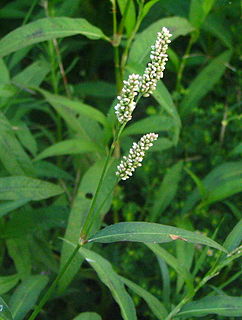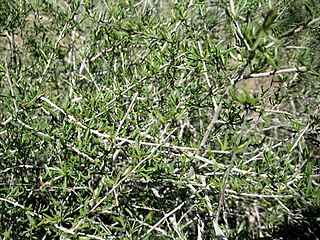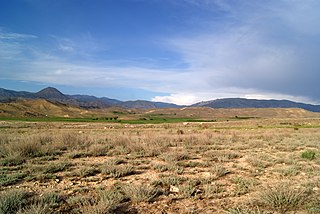
The Polygonaceae are a family of flowering plants known informally as the knotweed family or smartweed—buckwheat family in the United States. The name is based on the genus Polygonum, and was first used by Antoine Laurent de Jussieu in 1789 in his book, Genera Plantarum. The name may refer to the many swollen nodes the stems of some species have, being derived from Greek, poly meaning 'many' and gony meaning 'knee' or 'joint'. Alternatively, it may have a different derivation, meaning 'many seeds'.

The pomegranate is a fruit-bearing deciduous shrub in the family Lythraceae, subfamily Punicoideae, that grows between 5 and 10 m tall.

Dianthus caryophyllus, commonly known as the carnation or clove pink, is a species of Dianthus. It is likely native to the Mediterranean region but its exact range is unknown due to extensive cultivation for the last 2,000 years.

The International Union for Conservation of Nature (IUCN) Red List of Threatened Species, also known as the IUCN Red List or Red Data Book, founded in 1964, is the world's most comprehensive inventory of the global conservation status of biological species. It uses a set of precise criteria to evaluate the extinction risk of thousands of species and subspecies. These criteria are relevant to all species and all regions of the world. With its strong scientific base, the IUCN Red List is recognized as the most authoritative guide to the status of biological diversity. A series of Regional Red Lists are produced by countries or organizations, which assess the risk of extinction to species within a political management unit.

The Arabian Desert is a vast desert wilderness in Western Asia that occupies almost the entire Arabian Peninsula. It stretches from Yemen to the Persian Gulf and Oman to Jordan and Iraq. It occupies most of the Arabian Peninsula, with an area of 2,330,000 square kilometers (900,000 sq mi). It is the fifth largest desert in the world, and the largest in Asia. At its center is Ar-Rub' al-Khali, one of the largest continuous bodies of sand in the world. It is an extension of the Sahara Desert.

Gobustan District is one of the 66 districts of Azerbaijan. It is located in the east of the country and belongs to the Mountainous Shirvan Economic Region. The district borders the districts of Shamakhi, Khizi, Absheron, and Hajigabul. Its capital and largest city is Gobustan. As of 2020, the district had a population of 47,400.

The conservation status of a group of organisms indicates whether the group still exists and how likely the group is to become extinct in the near future. Many factors are taken into account when assessing conservation status: not simply the number of individuals remaining, but the overall increase or decrease in the population over time, breeding success rates, and known threats. Various systems of conservation status exist and are in use at international, multi-country, national and local levels as well as for consumer use.

Cheesman's gerbil is a small rodent in the subfamily Gerbillinae of the family Muridae. It is distributed mainly in Arabian Peninsula to southwestern Iran. It has orange-brown fur, white underparts, large eyes and a very long tail.

State Reserves of Azerbaijan refers to the state reserves in Azerbaijan, which preserve the fauna, flora and their ecosystems.
National Parks of Azerbaijan are run by the Ministry of Ecology and Natural Resources in the Republic of Azerbaijan. The first national park established was Zangezur National Park in 2003. Since then a further 9 national parks have been established; the most recent being the Gizilaghaj National Park in 2018.

Zangezur National Park — is a national park of Azerbaijan. It was established as the Ordubad National Park on an area of 12,131 hectares (121.31 km2) of Ordubad District of the Nakhchivan Autonomous Republic on June 16, 2003. On 25 November 2009 it was enlarged to 42,797 hectares (427.97 km2) and renamed to Zangezur National Park. This park is located in a mountainous area. It is cold in winter and hot in summer. The temperature changes between -30 °C to -10 °C in January and 10 °C 25 °C in July. The annual precipitation is 300–800 mm. The running water comes from Gilanchay, Vanadchay, Duylunchay, Aylishchay, Ganzachay, Kotamchay, Kilitchay and Ordubadchay rivers. Rains and melting snow constitute the main part of these rivers.

The Turkestan ground jay, grey ground jay or Pander's ground-jay is a species of bird in the crow and jay family, Corvidae. It is found in central Asia, particularly Kazakhstan, Turkmenistan, and Uzbekistan. More specifically, they tend to be found in Astragalus, Calligonum and southern Salsola vegetation zones. It is closely related to the Iranian ground jay. Its natural habitat is sandy desert with low shrub cover. It also forages around human settlements and roads.

Pteropyrum is a genus of plants in the family Polygonaceae. Plants of the World Online accepts two species, native to Iran, Oman and the Gulf States.

Calligonum is a genus of plants in the family Polygonaceae with about 80 species across the Mediterranean Sea region, Asia and North America.

Goravan Sands Sanctuary, is a state protected area in Ararat Province, Armenia.

Tourism in Azerbaijan has been an important sector of the Azerbaijani economy since the 1990s. According to Azerbaijan's Center for Economic and Social Development, the country is in 39th place among 148 countries in tourism competitiveness indicators. The World Travel and Tourism Council reported that Azerbaijan is among the top ten countries with the greatest increase in visitor exports from 2010 to 2016. The country had the world's fastest-developing travel and tourism economy in 2017. To promote tourism, Azerbaijan sponsored Atlético Madrid jerseys reading "Azerbaijan – Land of Fire". In 2018, a new tourism brand and a slogan "take another look" were introduced.
Calligonum leucocladum is a species of flowering plant in the family Polygonaceae. It is native to Central Asia and to Xinjiang in China. In Uzbekistan, it is limited to the Sokh River basin where it is endangered with a population fragmented by habitat loss from cutting and grazing.

The wildlife of Saudi Arabia is substantial and varied. Saudi Arabia is a very large country forming the bulk of the Arabian Peninsula. It has several geographic regions, each with a diversity of plants and animals adapted to their own particular habitats. The country has several extensive mountain ranges, deserts, highlands, steppes, hills, wadis, volcanic areas, lakes and over 1300 islands. The Saudi Arabian coastline has a combined length of 2640 km and consists of the Gulf of Aqaba and the Red Sea to the west while a shorter eastern coastline can be found along the Persian Gulf.
Iris camillae is a species in the genus Iris, it is also in the subgenus Iris and in the section Oncocyclus. It is a rhizomatous perennial, from Azerbaijan. It has narrow, falcate (sickle-shaped) leaves, medium-sized stem and large flowers, where the flower colour is very variable, ranging from violet, purple, pale blue, and also yellow, and occasionally bi-colour forms are found. It has a yellow beard. It is rarely cultivated as an ornamental plant in temperate regions, due to its environmental conditions of its natural habitat.

Calligonum comosum, the fire bush, arta or abal, is a species of flowering plant in the family Polygonaceae.
















